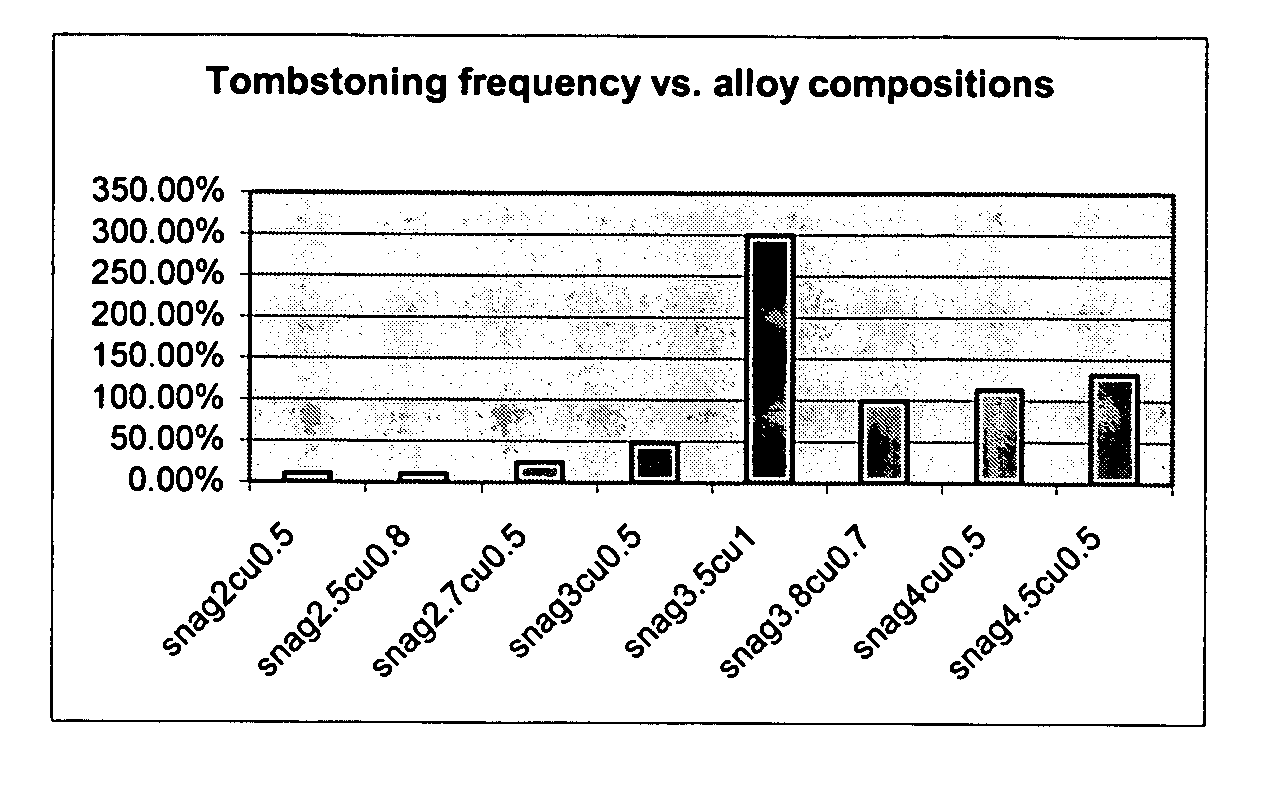Anti-tombstoning lead free alloys for surface mount reflow soldering
a lead free alloy and surface mount technology, applied in the direction of soldering apparatus, sustainable manufacturing/processing, final product manufacturing, etc., can solve the problems of easy disturbance of the surface tension of molten solder on the component, rapid increase of tombstoning defects, and toxic effects, etc., to reduce the effect of tombstoning
- Summary
- Abstract
- Description
- Claims
- Application Information
AI Technical Summary
Benefits of technology
Problems solved by technology
Method used
Image
Examples
example 1
Making a Solder
[0072] Soldering is an operation in which metallic parts are joined by a molten solder alloy whose melting temperature is generally below 450° C. There are many varieties of solder alloys based on tin and lead, but most recently, due to concerns about environmental and safety issues, Sn—Ag—Cu alloys have been widely used in soldering for electronics assembly. The technique of making solder paste is to mix solder powder with flux. First, the solder alloys are produced by melting ingredient metal ingots and mixing them into solder alloys. Then, the alloys are further atomized to solder powder by either a gas atomization or centrifugal atomization.
example 2
Soldering of Components
[0073] Soldering using a solder paste is called reflow soldering, which is considered the most widely employed soldering method in current electronic industries. There are generally four steps of reflow soldering. First, the solder paste (which is used to remove the metal oxide, thus allowing the solder to react with the pieces being joined; the solder paste is generally composed of metal powder plus flux or a reducing agent) is printed onto pads on a print circuit board. Second, a component is placed on the solder paste deposits. Third, the solder paste is heated above the melting temperature of the constituent solder alloy, and thus produces molten solder between the component and the pads. Finally, as the molten solders is cooled, solder joints are formed.
example 3
Tombstoning Test of Solder Pastes
[0074] A tombstoning test may be performed using an exaggerated severe soldering condition to produce tombstoning. The conditions are shown as follows: [0075] (a) A 0.25 mm thick stencil is used to produce a thick deposit of solder paste. When a small component is soldered to a pad with a thick deposit of solder, the frequency of tombstoning has been found to be greater.
[0076] (b) A vapor phase reflow oven is employed. The oven is full of vapor generated by heating a high boiling point fluid such as freon with coils at the bottom of the oven. As the printed circuit board is placed in the vapor, the solder paste is heated by the hot vapor and results in soldering of the components. Following the removal of the reflowed board, the tombstoned components are counted and the percentage of tombstones with respect to the number of components is used for comparison.
[0077] (c) A 20 cm×15.2 cm board with Cu pads is employed for testing the tombstoning effec...
PUM
| Property | Measurement | Unit |
|---|---|---|
| Temperature | aaaaa | aaaaa |
| Fraction | aaaaa | aaaaa |
| Fraction | aaaaa | aaaaa |
Abstract
Description
Claims
Application Information
 Login to View More
Login to View More - R&D
- Intellectual Property
- Life Sciences
- Materials
- Tech Scout
- Unparalleled Data Quality
- Higher Quality Content
- 60% Fewer Hallucinations
Browse by: Latest US Patents, China's latest patents, Technical Efficacy Thesaurus, Application Domain, Technology Topic, Popular Technical Reports.
© 2025 PatSnap. All rights reserved.Legal|Privacy policy|Modern Slavery Act Transparency Statement|Sitemap|About US| Contact US: help@patsnap.com



